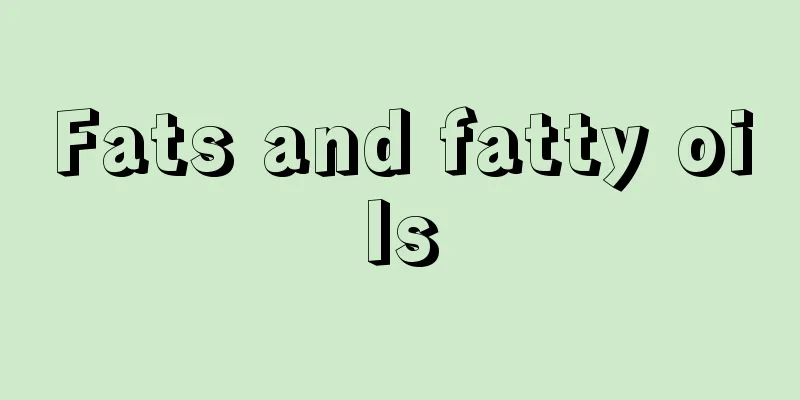Fats and fatty oils

|
A general term for substances whose main component is triglyceride, an ester of fatty acids and glycerin. Along with proteins and carbohydrates, it is one of the three main components of lipids that make up living organisms. Fats and oils are broadly divided into vegetable fats and animal fats. Those that are solid at room temperature are called fats, and those that are liquid are called fatty oils (or simply called oils). However, there is no clear-cut distinction between these. For example, the melting point of coconut oil is 20-28°C, and while it is considered a fatty oil (liquid) in tropical regions such as Southeast Asia, in Japan it is considered a fat (solid) except in the summer. As you can see from this example, it is generally difficult to classify fats and oils. Also similar to fats and oils are waxes. Plant and animal waxes are esters of fatty acids with monohydric (and sometimes dihydric) alcohols. ROH + R′COOH In the fields of medicine and nutrition, fats and fatty oils are not collectively referred to as fats, but as fats. Also, fats and oils and similar substances are called lipids, but in these fields lipids are sometimes called fats. [Kazuo Fukuzumi] ExistenceVegetable oils are found primarily in seeds and fruits. Oils are also produced by certain bacteria, molds, and yeasts. Animal fats are found in the subcutaneous tissue, abdominal cavity, liver, and intermuscular tissue of animals. [Kazuo Fukuzumi] Main component – fatty acidsThe higher fatty acids present as glycerides in natural fats and oils are saturated and unsaturated. They are usually straight-chain acids with an even number of carbon atoms and one carboxyl group. However, there are exceptions, including branched-chain acids with an odd number of carbon atoms. Naturally occurring unsaturated fatty acids are usually in the cis configuration. The major fatty acids in plant seed oils are palmitic, oleic, linoleic and linolenic acids. Some seed oils contain certain acids that are present only in certain plant families. Marine animal oils are composed of many kinds of unsaturated fatty acids, including saturated fatty acids, and contain polyunsaturated fatty acids with 18, 20, and 22 carbon atoms. The fatty acid composition of high-grade land animal fats is simpler than that of marine animal oils, consisting of palmitic acid, oleic acid, and often stearic acid. The fatty acids of amphibians, reptiles, birds, and rodents (rats, rabbits, etc.) are intermediate between the two mentioned above. The fatty oils of amphibians and reptiles contain significant amounts of unsaturated fatty acids with 20 and 22 carbon atoms, and the fatty acid composition of birds and rodents is closer to that of high-grade land animal fats than that of fish. [Kazuo Fukuzumi] Trace IngredientsUnsaponifiable matter (sterol, hydrocarbons), monohydric and dihydric alcohols (glyceryl ethers, etc.), vitamin E, vitamin A, carotenoids, vitamin D, vitamin K, water, etc. are included in the oil refining process. It also usually contains trace amounts of free fatty acids. [Kazuo Fukuzumi] Vegetable oilsThis refers to fats and oils obtained from plant seeds, fruits, etc. Those that are liquid at room temperature are called vegetable oils, and those that are solid are called vegetable fats. [Kazuo Fukuzumi] Vegetable oilVegetable oils are divided into three categories based on their properties. Those with an iodine value of 130 or more are called drying oils, those with an iodine value between 130 and 100 are called semi-drying oils, and those with an iodine value of 100 or less are called non-drying oils. If a thin layer of drying oil is left in the air, it will oxidize and solidify, forming a dry film. Non-drying oils do not form a dry film even if left for a long period of time. Semi-drying oils are somewhere in between, and will form a dry film if left for a long period of time. However, even within the same type of vegetable oil, the iodine value can vary slightly depending on the place of origin and the time of harvest. For example, soybean oil is sometimes classified as a drying oil, but sometimes as a semi-drying oil. [Kazuo Fukuzumi] Vegetable fatsThese include palm oil, palm kernel oil, coconut oil, cocoa butter, and wood wax. The first three are used as edible fats and soap, cocoa butter as edible fat, and wood wax as candles and polish. [Kazuo Fukuzumi] Animal fats and oilsThis refers to fats and oils obtained from animal fats and meat. They can be broadly divided into land animal fats and marine animal oils. When people simply say animal fats and oils, they usually mean the former. There are also amphibian oils and other types. [Kazuo Fukuzumi] Land animal fatUsually refers to high-quality land animal fat. It is generally fat, but occasionally contains fatty oils. If fat is pressed, fatty oils can be separated. It contains cholesterol as a minor component. There are usually only a few types of fatty acids that are the main components. However, the composition of milk fat from animals, especially ruminant animals, is complex, containing 5-30% short-chain fatty acids (4-10 carbon atoms). [Kazuo Fukuzumi] Marine animal oilThe fatty acids in marine fish are complex. The fatty acid composition of marine fish is different from that of freshwater fish. [Kazuo Fukuzumi] GenerateThe production of fats and oils in plants is unclear. It seems that carbohydrates synthesized by plants from carbon dioxide and water are converted into fats and oils. Fat and oils in animals are made from ingested fats and oils, carbohydrates, and proteins. Linoleic acid and linolenic acid are not synthesized in animals, but are obtained only from ingested fats and oils. Therefore, linoleic acid and linolenic acid are called essential fatty acids. [Kazuo Fukuzumi] Fat and oil metabolismIt was said that fats and oils are hardly digested in the stomach, but in the small intestine, where they are hydrolyzed and absorbed by the combined effect of bile and pancreatic enzymes, and that fatty acids and glycerin are recombined inside the small intestinal wall. However, it is now believed that most fats and oils pass through the small intestinal wall in a highly emulsified state without being hydrolyzed. 60% of digested fats and oils enter the bloodstream through the thoracic duct. The remaining 40% of fats and oils are transported to the liver through the portal vein. It seems that digested fats and oils are resynthesized here. It also seems that fats and oils are synthesized from carbohydrates and proteins. Fat and oils are transported from the liver to various parts of the body through blood vessels. Fat and oils are stored as reserve food in adipose tissue. They also become a component of cell membranes in the form of phospholipids. The calories of metabolized fats and oils are more than twice as high as those produced by proteins or carbohydrates. The oxidation of fats and oils in the body is by β-oxidation. They are oxidized and split into two carbon units in stages, becoming carbon dioxide and water. Fatty acids are synthesized in animals from two-carbon units, but it is not thought to be simply the reverse of fatty acid biosynthesis. [Kazuo Fukuzumi] Manufacturing methodThe industrial production of fats and oils is by the squeezing method, the solvent extraction method and the leaching method. Of these, the leaching method is limited to the production of animal fats and oils. The production of vegetable fats and oils is by the squeezing method and the solvent extraction method. [Kazuo Fukuzumi] Oil ExtractionTo maximize the oil recovery rate, the oil-bearing material must be heat-treated to adjust the moisture content. The best conditions for this cooking process depend on the pressing method or solvent extraction method. For example, in the expeller (continuous press) pressing method, the moisture content is adjusted to 2-5%. Currently, expellers that perform continuous spiral pressing are widely used in pressing methods. The continuous method of solvent extraction is widely used, and since its introduction, it has rapidly replaced other oil recovery methods. Continuous solvent extraction equipment can be broadly divided into permeation type and total immersion type. Both incorporate countercurrent operation to improve the extraction rate. [Kazuo Fukuzumi] purificationFats and oils are refined in order to remove the following components contained in crude oil: colloidal dissolved substances, free fatty acids, coloring substances, odorous substances, and saturated glycerides. To remove colloidal dissolved substances, the oil is left to stand or washed with an acid. To remove free fatty acids, the oil is refined with alkali. Nowadays, the continuous method is widely used. Decolorization is usually performed under reduced pressure at about 120°C using activated clay. Usually, deodorization is performed using reduced pressure steam in a semi-continuous or continuous deodorizing tank. To partially remove saturated glycerides, the oil is winterized (also called cold clearing). That is, the oil is left in a freezer at 5°C, and then the crystalline glycerides are removed using a filter press. [Kazuo Fukuzumi] HydrogenationThe addition of hydrogen to the unsaturated bonds of fat molecules is called hydrogenation or fat hardening, and is a catalytic reaction. Nickel catalyst is used industrially. Before hydrogenation, fats and oils are pretreated, i.e., alkaline refining and decolorization with activated clay. Hydrogenation or partial hydrogenation of fats and oils is carried out on a large scale in the processing of fats and oils for margarine, shortening, and soap. Hydrogenation improves the color of the oil and eliminates unpleasant odors and tastes, but produces a characteristic hydrogenated odor. Temperature, pressure, catalyst, mixing effect, and purity of oil and hydrogen determine the rate of hydrogenation reaction and affect the direction of the reaction. For selective hydrogenation (e.g., converting diunsaturated bonds to mostly monounsaturated bonds before hydrogenating monounsaturated bonds to saturated compounds), pressures of 1.5 to 3 atmospheres and a temperature of about 175°C are optimal. In general, low pressure, high temperature, high catalyst concentration, and low gas dispersion in the oil are favorable for selectivity. Selective hydrogenation is often performed, but because the conditions required are complex, a batch process is usually used. A continuous process is also available, but is not widely used. During hydrogenation, trans isomers and positional isomers are produced. Recently, a new reaction system has been discovered that produces no trans isomers and has a 100% selectivity. [Kazuo Fukuzumi] Chemistry of fats and oilsThe chemical properties of fats and oils are based on fatty acids and glycerin, and undergo chemical changes such as hydrolysis and oxidation. [Kazuo Fukuzumi] Oil and fat decompositionThe process of hydrolyzing triglycerides to obtain fatty acids and glycerin is generally called fat splitting. There are three types of fat splitting: the Twitchell process, which uses an acid catalyst; the autoclave process, which uses a base catalyst; and the continuous process, which operates at high temperature and pressure without using a catalyst. In the high-temperature, high-pressure continuous process, a temperature of 260°C and a pressure of 49 atmospheres are used. Metals that are resistant to corrosion by fatty acids under these conditions include Inconel (a type of nickel alloy, with excellent corrosion resistance) and 316-type stainless steel. This material makes this continuous process possible. In the Twitchell process, a sulfonic acid with a lipophilic part called the Twitchell reagent is used as a catalyst. This reaction is a heterogeneous reaction, and although it was previously called an oil-water interface reaction, it was discovered that not only the interface reaction but also reactions in the oil layer and the water layer are involved, and that the reaction in the water layer is a micellar reaction. In the autoclave process, which uses a base catalyst, zinc oxide, magnesium oxide, calcium oxide, etc. are used. In addition, there is an enzymatic method for decomposing fats and oils using castor lipase. Although this method is advantageous from the standpoint of energy saving, it is not used industrially except in a few cases because the lipase is unstable. [Kazuo Fukuzumi] Soap manufacturing, saponificationWhen fats and oils are heated with an alkali such as sodium hydroxide, fatty acid salts, or soaps, are produced and glycerin is liberated. The free fatty acids react with soda ash or other suitable carbonates to produce soap. For nearly 2000 years, water-soluble soaps were the primary detergent, but in recent years, synthetic detergents have made remarkable inroads and have taken over the dominant role. However, solid bath soaps and the like have remained stable. [Kazuo Fukuzumi] Autoxidation of olefin chainsOxidation of olefin chains in fats and oils by oxygen in the air, i.e. autoxidation, is important in relation to rancidity of fats and oils, film formation of drying oils, and boiled oil production. First, lipid peroxides (hydroperoxides) are produced, followed by the formation of aldehydes, ketones, short-chain fatty acids, alcohols, hydrocarbons, oxidized polymers, and water. Incidentally, the lipid peroxide theory has been published as a cause of aging and lifestyle-related diseases (adult diseases). [Kazuo Fukuzumi] Thermal polymerization of olefin chainsWhen oils and fats are heated at high temperatures in an airtight container, they polymerize. This is important for the production of stand oil. [Kazuo Fukuzumi] EsterificationFatty acid esters can be prepared by direct esterification, in which fatty acids are heated with monohydric or polyhydric alcohols in the presence of a mineral acid catalyst, or by transesterification, in which fatty acids are reacted with monohydric or polyhydric alcohols in the presence of a mineral acid catalyst. [Kazuo Fukuzumi] Reduction to alcoholHigher alcohols are particularly important as raw materials for the manufacture of synthetic detergents. There are two industrial methods for reducing fats and oils to alcohol: sodium reduction (starting from esters) and hydrogenolysis (starting from fatty acids or esters). In addition, there are reactions that produce acyl halides, acid anhydrides, ketones, aldehydes, hydrocarbons, and nitrogen derivatives. Among the nitrogen derivatives, amines and their derivatives are important compounds. [Kazuo Fukuzumi] "Oil Chemistry Handbook, 2nd Revised Edition, edited by Japan Oil Chemists' Association (1971, Maruzen)" [Reference] | | | | |Source: Shogakukan Encyclopedia Nipponica About Encyclopedia Nipponica Information | Legend |
|
脂肪酸とグリセリンのエステル、すなわちトリグリセリドを主成分とする物質の総称。タンパク質、炭水化物とともに脂質として生物体を構成する三大要素の一つである。 油脂は、植物油脂と動物油脂に大別される。それぞれに、常温で固体のものを脂肪fats、液体のものを脂肪油fatty oils(単に油(あぶら)ともいう)と称する。しかし、これらの間にはっきりとした区別があるわけではない。たとえば、やし油の融点は20~28℃で、東南アジアなど熱帯原産地では脂肪油(液体)であるが、日本では夏季を除いては脂肪(固体)である。この例でもわかるように、油脂を分類することは一般にむずかしい。 また、油脂に似たものにろうがある。植物および動物ろうは、脂肪酸と一価アルコール(ときには二価アルコール)とのエステルである。 ROH + R′COOH 医学、栄養学関連分野では、脂肪と脂肪油とを一括して油脂とはいわず、脂肪とよんでいる。また、油脂およびその類似物質を脂質というが、これらの分野では、脂質を脂肪と称する場合がある。 [福住一雄] 存在植物油は主として種子や果実中に存在している。また、油脂はある種のバクテリア、カビ、酵母によって生産される。動物脂肪は動物の皮下組織、腹部腔(こう)、肝臓、筋肉間結締組織にある。 [福住一雄] 主要成分―脂肪酸天然油脂中にグリセリドとして存在する高級脂肪酸は、飽和および不飽和脂肪酸である。それらは通常偶数個の炭素原子をもち、一つのカルボキシ基(カルボキシル基)をもつ直鎖酸である。しかし例外があり、なかには奇数炭素原子を有する分枝鎖酸がある。天然の不飽和脂肪酸は通常シス形である。植物種子油の主要成分脂肪酸は、パルミチン酸、オレイン酸、リノール酸およびリノレン酸である。若干の種子油はある植物族のみに存在する特定の酸を含有している。 海産動物油は多種類の不飽和脂肪酸からなり、かつ飽和脂肪酸を含む。また炭素数18、20、22の高度不飽和脂肪酸を含有している。高級陸産動物脂の脂肪酸組成は、海産動物油に比し単純であり、パルミチン酸、オレイン酸、しばしばステアリン酸である。両生類、爬虫(はちゅう)類、鳥および齧歯(げっし)類(ネズミ、ウサギなど)の成分脂肪酸は、前述の二つの中間にある。両生類および爬虫類の脂肪油は、かなりの量の炭素数20、22の不飽和脂肪酸を含み、鳥および齧歯類は、魚よりも高級陸産動物脂の脂肪酸組成に近い。 [福住一雄] 微量含有成分不けん化物(ステリン、炭化水素)、一価アルコール、および二価アルコール(グリセリルエーテルなど)、ビタミンE、ビタミンA、カロチノイド、ビタミンD、ビタミンK、水などが製油過程で介在してくる。また通常、微量の遊離脂肪酸を含む。 [福住一雄] 植物油脂植物の種子、果実などから得られる油脂をいう。常温で液体のものを植物油、固体のものを植物脂とよんでいる。 [福住一雄] 植物油植物油はその性状により次の三つに分けられる。すなわち、ヨウ素価130以上のものを乾性油、130~100のものを半乾性油、100以下のものを不乾性油という。乾性油は、薄層にして空気中に放置すれば、酸化固体化して乾燥膜となる。不乾性油は、長期にわたり放置しても乾燥膜を生じない。半乾性油はこの中間のもので、長期放置により乾燥膜を生成する。しかし同一種類の植物油においても、産地、採油時期などによってヨウ素価は多少相違する。たとえば、大豆油は乾性油に分類される場合があるけれども、半乾性油に分類される場合もある。 [福住一雄] 植物脂パーム油、パーム核油、やし油、カカオ脂、木ろうなどがある。前三者は食用脂・せっけん、カカオ脂は食用脂、木ろうはろうそく・つや出し料などに用途がある。 [福住一雄] 動物油脂動物の脂肉などから得られる油脂をいう。大別して、陸産動物脂と海産動物油とがある。単に動物油脂といえば前者をさすことが多い。そのほか両生動物油などがある。 [福住一雄] 陸産動物脂通常は、高級陸産動物脂をさす。だいたいにおいて脂肪であるが、まれに脂肪油がある。脂肪もこれを圧搾すれば脂肪油を分離する。微量成分としてコレステリンを含有。主要成分脂肪酸の種類は通常少ない。しかし動物とくに反芻(はんすう)動物のミルク脂の成分は複雑で、5~30%の短鎖脂肪酸(炭素数4~10)を含む。 [福住一雄] 海産動物油成分脂肪酸は複雑である。ちなみに海水魚と淡水魚とでは脂肪酸成分が異なる。 [福住一雄] 生成植物中での油脂の生成は、はっきりしない。炭酸ガスと水とから植物により合成される炭水化物が油脂に変化するらしい。動物体中の油脂は、摂取油脂、炭水化物、タンパク質からつくられる。リノール酸、リノレン酸は動物体中では合成されず、摂取油脂のみから得られる。よってリノール酸、リノレン酸を必須(ひっす)脂肪酸という。 [福住一雄] 油脂の新陳代謝油脂の消化は、胃ではほとんど行われず、小腸で行われ、胆汁とすい臓酵素の組み合わされた効果で加水分解されて吸収され、小腸壁の内部で脂肪酸とグリセリンは再結合されるらしいといわれた。しかし現在では、大部分の油脂は加水分解されないで、高乳化状態で小腸壁を通過するといわれている。消化油脂の60%が胸管を通って血液中に入る。残り40%の油脂は門脈を通って肝臓に運ばれる。消化油脂はここで再合成されるらしい。また炭水化物、タンパク質からも油脂が合成されるらしい。油脂は肝臓から血管により種々の部分に運ばれる。油脂は脂肪組織中に保留食物として貯蔵される。またリン脂質の形で細胞膜構成分となる。新陳代謝される油脂のカロリーは、タンパク質あるいは炭水化物によって生ずるカロリーの2倍より大である。油脂の生体内酸化はβ(ベータ)‐酸化による。二つの炭素単位ずつ階段的に酸化分裂され、炭酸ガスと水とになる。動物体内における脂肪酸合成は、二炭素単位から合成されるというが、単に脂肪酸生合成の逆ではないと考えられている。 [福住一雄] 製造法油脂の工業的生産は、圧搾法、溶剤抽出法および溶出法による。これらのうち溶出法は動物油脂の生産に限られている。植物油脂の生産は圧搾法および溶剤抽出法によっている。 [福住一雄] 採油採油率を最高にするために、含油物質を熱処理して水分量を調節する必要がある。この蒸煮操作の最良条件は、圧搾法あるいは溶剤抽出法に左右される。たとえば、エキスペラー(連続圧搾機)による圧搾法では水分量を2~5%に調節する。現在、圧搾法では連続螺旋(らせん)圧搾を行うエキスペラーが広く用いられている。溶剤抽出法はその連続法が広く行われ、この方法の出現以来、他の採油方法は、この方法に急激に広く置き換えられた。連続溶剤抽出装置には大別して浸透型と全浸型とがある。いずれも向流操作を取り入れ、抽出率を良好にしている。 [福住一雄] 精製原油中に含まれる次の成分を除去する目的で、油脂の精製を行う。すなわち、コロイド溶解物質、遊離脂肪酸、着色物質、有臭物質、飽和グリセリドを除去する。 コロイド溶解物質を除去するために、静置あるいは酸洗いを行う。遊離脂肪酸除去の目的で、アルカリ精製する。現今その連続法が多用される。通常、活性白土による約120℃における減圧脱色をする。普通、半連続あるいは連続脱臭缶を用いて、減圧水蒸気脱臭を行う。飽和グリセリドを部分的に除去するために、ウィンターライジング(コールドクリアリングともいう)をする。すなわち、5℃の冷凍室に油を放置してから、結晶グリセリドをフィルタープレスにかけて除去する。 [福住一雄] 水素添加油脂分子の不飽和結合に水素が付加することを、水素添加、油脂硬化というが、これは触媒反応である。工業的にはニッケル触媒を用いる。水素添加する前に油脂の予備処理を行う。すなわち、アルカリ精製および活性白土による脱色である。油脂の水素添加あるいは部分的水素添加は、マーガリン、ショートニング、せっけん原料油脂の処理で大規模に行われる。水素添加により油の色相は良好になり、いやな臭(にお)いおよび味がなくなる。しかし特有の水素添加臭を生ずる。温度、圧力、触媒、混合効果、油および水素の純度は、水素添加反応速度を決め、反応方向に影響を及ぼす。選択的水素添加(たとえばジ不飽和結合をほとんどモノ不飽和結合にしてから、モノ不飽和結合に水素添加して飽和化合物にする段階に移る)をする際には、1.5~3気圧の圧力、約175℃が最適である。一般に低圧、高温、高触媒濃度、油中のガス分散度が低いことが、選択性に有利である。選択的水素添加を行うことも多く、この条件設定は複雑であるから、通常回分法が行われる。連続法もあるが広くは行われない。水素添加中トランス異性体、位置異性体が生成する。最近トランス異性体無生成、選択率100%の新反応系がみいだされた。 [福住一雄] 油脂の化学油脂の化学的性質は、脂肪酸、グリセリンのそれに基づいており、加水分解、酸化などの化学変化をおこす。 [福住一雄] 油脂分解トリグリセリドを加水分解して脂肪酸とグリセリンを得る方法を一般に油脂分解という。油脂分解には、酸触媒を用いるトイッチェル法、塩基触媒を用いるオートクレーブ法、触媒を用いず高温・高圧で操作する連続法がある。高温高圧連続法では、260℃の温度、49気圧の圧力を用いる。この状態で脂肪酸に耐食性を有する金属としてインコネル(ニッケル合金の一種。耐食性に優れている)か316型不銹(ふしゅう)鋼がある。この材質のおかげでこの連続法が可能になった。トイッチェル法では、トイッチェル試薬と称する親油性部を有するスルホン酸を触媒として用いる。この反応は不均一系の反応であり、以前は油‐水界面反応といわれたが、界面反応のみならず、油層さらに水層内での反応も関与すること、および水層内反応はミセル反応であることがわかった。塩基触媒を用いるオートクレーブ法の場合には、酸化亜鉛、酸化マグネシウム、酸化カルシウムなどを使用する。このほかヒマシリパーゼを用いる酵素法油脂分解があるが、省エネルギー見地からはよいけれども、リパーゼが不安定であるために、一部を除き工業的には行われていない。 [福住一雄] せっけん製造、けん化油脂を水酸化ナトリウムのようなアルカリと加熱すれば、脂肪酸塩すなわちせっけんが生成し、グリセリンが遊離する。遊離脂肪酸は、ソーダ灰あるいは他の適当な炭酸塩と反応してせっけんになる。2000年近くの間水溶性せっけんは主要洗剤として役だったが、近年合成洗剤の進出が目覚ましく、これに主座を奪われた。しかし固形浴用せっけんなどは横ばい状態にある。 [福住一雄] オレフィン鎖の自動酸化油脂中オレフィン鎖の、大気中の酸素による酸化すなわち自動酸化は、油脂の酸敗および乾性油の皮膜形成、ボイル油製造に関連して重要である。まず過酸化脂質(ヒドロペルオキシド)を生じ、ついでアルデヒド、ケトン、短鎖脂肪酸、アルコール、炭化水素、酸化重合体、水を生成する。ちなみに、老化、生活習慣病(成人病)発生原因として過酸化脂質説が発表されている。 [福住一雄] オレフィン鎖の加熱重合空気を遮断して高温で油脂を加熱すれば重合する。スタンド油製造に重要である。 [福住一雄] エステル化脂肪酸エステルは、直接エステル化あるいはエステル置換により調製される。直接エステル化の場合には、脂肪酸を鉱酸を触媒として一価あるいは多価アルコールと加熱する。エステル置換には、アルコーリシス、アシッドリシス、およびエステル基交換がある。 [福住一雄] アルコールへの還元高級アルコールはとくに合成洗剤の製造原料として重要である。油脂のアルコールへの還元には、工業的に二つの方法、すなわちナトリウム還元法(原料はエステル)と加水素分解(原料は脂肪酸あるいはエステル)とがある。このほか、アシルハライド、酸無水物、ケトン、アルデヒド、炭化水素、窒素誘導体などを生成する反応がある。窒素誘導体ではアミンおよびそれらの誘導体が重要な化合物である。 [福住一雄] 『日本油化学協会編『油脂化学便覧』改訂2版(1971・丸善)』 [参照項目] | | | | |出典 小学館 日本大百科全書(ニッポニカ)日本大百科全書(ニッポニカ)について 情報 | 凡例 |
>>: Usance - Usance (English spelling)
Recommend
Nagano Ushikasegi - Nagano Ushikasegi
A packer from Nakamura Village, Chikuma County, Sh...
Kamado (stove) - Kamado
A facility used for cooking food. 【China】 In the N...
Pelagia panopyra (English spelling)
...They paralyze small fish with nematocyst venom...
Nelson, E.
... The above-mentioned method of using model the...
Tāi xī (English spelling)
A method of training in Chinese Taoism. According ...
Self-determination of nations
A political principle that each nation determines ...
ganglioside
… Sialic acid is often present at the non-reducin...
Decoy display - Decoy display
In Japan, the regulation of unfair price indicati...
Kamikitayama [village] - Kamikitayama
A village in Yoshino District, southeastern Nara P...
Sea red - Kaikou
A haiku magazine. It was founded in March 1915 (T...
Galactic Corona
...In addition, it is known that young forming st...
Memorial - Memorial
A classification of cultural properties. They are...
Hydrocarbons - Tankasuiso (English spelling)
A general term for compounds consisting only of c...
Zenigata Heiji the Detective - Zenigata Heiji the Detective
A novel written by Nomura Kodo. Published in All Y...
Yaḥyā Doulatābādī (English spelling)
1863‐1939 A modern Iranian cultural and educationa...









